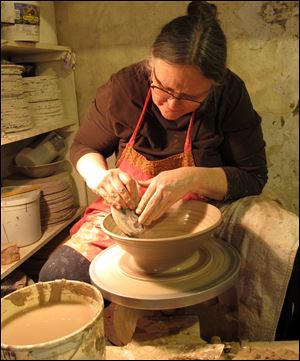
Old Wisconsin mining town remade into an arts destination
7/20/2014
Potter Diana Johnston works in her studio in Mineral Point, Wis. Johnston lives with her husband, Tom, in the malting tower of an old brewery which they have converted into an enormous pottery studio.
MINERAL POINT, Wis. — This tiny town is a charming place where old stone buildings hug the hills, and artists’ galleries, pottery studios, and antiques shops line the streets.
Whimsical free libraries — handcrafted miniature houses that look like birdhouses filled with books — are tucked into street corners. A thriving arts center draws people from around the country to study everything from blacksmithing and bent twig furniture to the Cornish language. And there is an outdoor theater carved into a limestone quarry and a beautifully restored Opera House dating to 1914.
But perhaps the most extraordinary thing about Mineral Point, (population 2,500), nestled in the hills of southern Wisconsin, is that it even exists.
Mineral Point’s original lead miners lived in crude shelters that resembled badger holes and were the origins of Wisconsin’s nickname, the Badger State. In the 1800s, the town’s rich mineral deposits attracted emigrants from Cornwall and for a time it became one of the state’s largest cities. Eventually the miners left, lured by California gold, and the town declined. By the 1930s, the old stone houses were dilapidated and the place was nearly extinct.
“The whole town was pretty decrepit,” wrote Robert Moser Neal, describing his shock when he returned from years abroad to find his hometown dying. So Neal, and his partner, Edgar Hellum (the two met at the Art Institute of Chicago) decided to devote their lives to saving Mineral Point.
Neal wrote that locals laughed when the men bought a crumbling limestone cottage on Shake Rag Street, so named because miners’ wives shook white rags when it was time for the men to return from the hills for dinner.
They set about restoring it and, though they had little culinary experience, they opened a restaurant in the 1930s called Pendarvis House — named after an estate in Cornwall, England. The tiny, 20-seat premises sold Cornish pasties (meat and potatoes wrapped in pastry), saffron cake, and tea.
Neal had lived in London, and the English sensibilities he brought to the restaurant quickly made it a hit among the intelligentsia. Frank Lloyd Wright, Marjorie Kinnan Rawlings, Sinclair Lewis, and Duncan Hines all dined there. Eleanor Roosevelt was reportedly once turned away for showing up late and the Saturday Evening Post named it one of the finest restaurants in the country.
With money from their restaurant, the men began buying and restoring other buildings, attracting preservationists and artists alike. Old breweries were transformed into pottery studios, meat markets became galleries, and so began a flourishing artistic community.
Today, costumed guides offer tours of Pendarvis and other restored buildings interpreting the history of Cornish settlement and Wisconsin’s lead-mining heyday, including a replica of a Cornish pub. The site is listed on the National Register of Historic Places. A life-size cutout of Neal and Hellum greets visitors and photographs of their restorations line the walls of the restaurant. When he died in 2000 at the age of 96, Hellum was widely hailed, along with Neal, as a creator of the modern town. Neal died in 1989.
But their spirit of preservation and creativity lives on among the town’s 80 or 90 artists, many living in lofts above their studios. High Street bustles with galleries, everyone knows everyone, and there is a collective sense of near-bemusement — as well as gratitude — that their community still thrives.
Locals chuckle at how a newspaper report once described them as “pathologically friendly” — and promptly prove the point by inviting strangers into their homes and studios. “Everyone is important here and no one is too important,” says Diana Johnston, a potter, who lives with her husband in the malting tower of an old brewery which they have converted into a pottery studio. “People are following their dreams whatever those dreams are and that makes for such a great sense of creative spirit and adventure and fun.”
Bruce Howdle, who creates enormous ceramic sculptures, attributes the town’s draw to the “three A’s — art, antiques and architecture — as well as the rolling hills, the extraordinary collage of people, and the welcoming environment.”
The town has retained a particular brand of quirkiness too. The century-old opera house, a former vaudeville hall, also functions as a free cinema. Because of complicated copyright issues, it cannot advertise the movies it shows. Instead a poster outside offers a vague description (“A riveting drama about two boys who find a fugitive — who is very nice-looking and often shirtless”) and movie-goers are left to guess the film.
Or they can simply pop next door and ask the pathologically friendly folks at Town Hall.
If You Go
MINERAL POINT, WISCONSIN.: About 50 miles from Madison, about 130 miles from Milwaukee, http://mineralpoint.com
PENDARVIS HISTORIC SITE: Open daily, May 7-Oct. 31, 10 a.m.-5 p.m. Adults: $10; students/seniors, $8:50; children, $5. Guided tours available, http://pendarvis.wisconsinhistory.org
SHAKE RAG ALLEY, CENTER FOR THE ARTS: Visiting the campus is free, including historic buildings, gardens, stone walls, and paths. Workshop details: www.shakeragalley.com
ALLEY STAGE: Performance schedules, www.shakeragalley.com/show-schedule
CORNISH FESTIVAL: Sept. 27-28, http://mineralpoint.com/events/cornish-festival